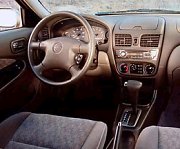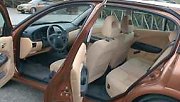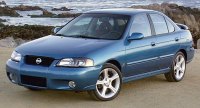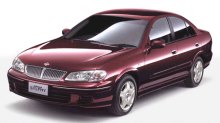 Nissan
no longer provides the most complicated model range in the world. I
remember
less than 2 years ago I did a study for all major car makers, resulted
that Nissan offered the most models as well as individual platforms
among
them, even beating the Japan's no. 1, Toyota.
Today, the struggling number
two (well, it should be no. three now, after loosing the second place
to
Honda recently) has abandoned a lot of model names as well as platforms
for the benefit of cost efficiency. Even the big-selling models like
the
C-segment cars - Sunny for Japan, Almera for Europe and Sentra for USA
- have to accept the highest level of standardisation ever experienced.
Not only engines, suspension, transmission, but actually the whole
floorpan
and interior packaging have to share with one another. Nissan
no longer provides the most complicated model range in the world. I
remember
less than 2 years ago I did a study for all major car makers, resulted
that Nissan offered the most models as well as individual platforms
among
them, even beating the Japan's no. 1, Toyota.
Today, the struggling number
two (well, it should be no. three now, after loosing the second place
to
Honda recently) has abandoned a lot of model names as well as platforms
for the benefit of cost efficiency. Even the big-selling models like
the
C-segment cars - Sunny for Japan, Almera for Europe and Sentra for USA
- have to accept the highest level of standardisation ever experienced.
Not only engines, suspension, transmission, but actually the whole
floorpan
and interior packaging have to share with one another.
  However, I suspect if the styling were responsible by Nissan's studio in Brussel, it would have been a world class beauty. Brussel has a good track record recently, especially is the Tino MPV and last year's Kyxx concept car. Despite of different clothes, the three sister cars have virtually the same floorpan. Even the American Sentra has to share the same width and 2535 mm wheelbase as the other two, no wonder people said it is not as roomy as the Civic, let alone the class-leading Focus. The unusually short wheelbase also implies that the platform is derived from the previous generation Sunny / Sentra / Almera. Nissan didn't increase all the essential dimensions other than height. Although it always claim the multi-link beam axle rear suspension is extremely space-saving, I found my 5 ft 10 body was quite compromised in the previous Sunny which has the same wheelbase. Therefore although the new car has higher roof, hence a relatively upright rear seat, space at the rear is still hardly impressive. Suspension is virtually unchanged from last generation. Nevertheless, chassis has gained 30% in torsional stiffness by means of strengthening including a cross-member at the floorpan, thus improve refinement in the price of weight penalty. It's generally a few dozens of kg heavier, not a good thing because the progress of powertrain is tiny. In some cases, like the domestic best-selling 1.5 model, even has the power output tuned down (accompany with compression ratio) to cope with stricter emission regulations. Luckily, there is a new 1.8-litre direct-injection engine (130hp) for compensation. Instead of direct-injection, European 1.8 gets a simple variable-valve timing at the intake valves to boost flexibility. That results in a peak torque of 117 lbft occurring from 2,400 rpm continuously to 4,800 rpm. Power, on the other hand, is as modest as 114 hp. Worst of all, this is already the range-topping engine for Almera - no 143 hp GTi anymore; no any 2-litre engine up to this moment. I think the Almera deserve at least Sentra's 1.8, which received higher state of tune, hence 126 hp and 129 lbft. It would have been even better if it gets Sentra SE's 145 hp 2-litre engine with dual variable-volume exhaust. But Sentra also has its problems. Although it gained front tower bar as standard and a bit more power than before, its new found weight prevent it from feeling as "pocket-rocket" as the previous SE-R or even the 2-door 200SX (not the Silvia). In short, both Sentra and Almera are actually slower than their equivalent predecessors. In handling department, Almera's suspension tuning is very well done. Benefited by stiffer chassis, the Almera provides good balance between handling and ride. The simple multi-link beam axle has overcome its shortcomings in dealing with short / sharp bumps (unless in aggressive optional 205/50 WR16 rubbers), providing generally supple ride quality. Body control is good and fluent, very easy to handle. Slick gearchange and progressive clutch further enhance the sense of confidence. Steering weighs good and delivers decent feel, but not as sharp as keen drivers like. In contrast,
refinement and
perceived quality are the biggest faults for all these cars. The 1.8
engine
is not as smooth as Japanese norm, and makes a lot of noise.
There's vibration
transmitted to the pedals too. Wind noise suppression is less
impressive
as well.   In the VW-dominating era, nearly all other cars' dashboards can be criticised as cheap. Still, I found the Focus and Civic's looking more expensive than the Nissan compacts. They are more stylish as well, especially is the former. Nissan's Germany studio, which responsible for the interior design for both Almera and Sentra, didn't inject sufficient style to compensate the lack of high quality plastic. The dark, shiny, hard-touch dashboard adds nothing to showroom appeal. Being produced in
Japan,
Mexico and UK respectively, the Sunny, Sentra and Almera represent the
same philosophy via different interpretations. This philosophy is: cost
reduction. Unluckily, before customers discover that from the price
tag,
they have already perceived that. |
| The above report was last updated on 11 Apr 2000. All Rights Reserved. |
 Let's
start from the exterior, this is where the Sunny, Sentra and Almera
differ
the most, because they were penned by different studios. The Sunny,
unsurprisingly,
was the work of domestic designers. This could be reflected by its
conservative
and rather straightforward style. The Sentra was styled by American
stylists
in the San Diego studio. Sadly, it also looks dull, unlike a product of
the new millennium, although there is a special grille at the front
bumper.
Comparatively, if not absolutely, the work of the European studio at
Germany
did the best to the Almera's styling.
It's unique, modern and reflects
the confidence the designers have, unlike the Japanese and American
colleagues
who compromised their designs for the requirements of Mr. Average and
Mrs.
Robinson. In particular, in the hatchback form
you'll see a special, wave-shape
roofline which drops and then rise towards the tailgate, forming an
inherent
roof spoiler. In sedan form, the Almera looks rounder and bolder than
the
Sentra, delivering a safe yet funny feel. Interestingly, it looks quite
like parent company's Renault Megane.
Let's
start from the exterior, this is where the Sunny, Sentra and Almera
differ
the most, because they were penned by different studios. The Sunny,
unsurprisingly,
was the work of domestic designers. This could be reflected by its
conservative
and rather straightforward style. The Sentra was styled by American
stylists
in the San Diego studio. Sadly, it also looks dull, unlike a product of
the new millennium, although there is a special grille at the front
bumper.
Comparatively, if not absolutely, the work of the European studio at
Germany
did the best to the Almera's styling.
It's unique, modern and reflects
the confidence the designers have, unlike the Japanese and American
colleagues
who compromised their designs for the requirements of Mr. Average and
Mrs.
Robinson. In particular, in the hatchback form
you'll see a special, wave-shape
roofline which drops and then rise towards the tailgate, forming an
inherent
roof spoiler. In sedan form, the Almera looks rounder and bolder than
the
Sentra, delivering a safe yet funny feel. Interestingly, it looks quite
like parent company's Renault Megane.  This
can only happen in America the dreamland - base on Nissan Sentra, they
install a large motor, 6-speed box, beefed-up suspensions, front tower
bar, limited-slip differential, 215/45ZR17 rubber ... and lastly a
badge
reading "Spec V". While the name is an inversion of Skyline GT-R's "V
Spec",
they forget that Sentra is uninspiring to drive and probably not a good
basis for hot conversion - unless what you pursue is 1/4 miles
acceleration
or skidpad g-force.
This
can only happen in America the dreamland - base on Nissan Sentra, they
install a large motor, 6-speed box, beefed-up suspensions, front tower
bar, limited-slip differential, 215/45ZR17 rubber ... and lastly a
badge
reading "Spec V". While the name is an inversion of Skyline GT-R's "V
Spec",
they forget that Sentra is uninspiring to drive and probably not a good
basis for hot conversion - unless what you pursue is 1/4 miles
acceleration
or skidpad g-force.
 Cost
reduction led to the death of the long-serving Bluebird range. However,
Nissan wants to keep this name alive (maybe useful in the future), thus
created this Bluebird Sylphy base on the Sunny. Mechanically identical,
just has a bit more up-market styling and an option of 2.0
direct-injection
engine (150hp) mated with CVT-M6.
Cost
reduction led to the death of the long-serving Bluebird range. However,
Nissan wants to keep this name alive (maybe useful in the future), thus
created this Bluebird Sylphy base on the Sunny. Mechanically identical,
just has a bit more up-market styling and an option of 2.0
direct-injection
engine (150hp) mated with CVT-M6.